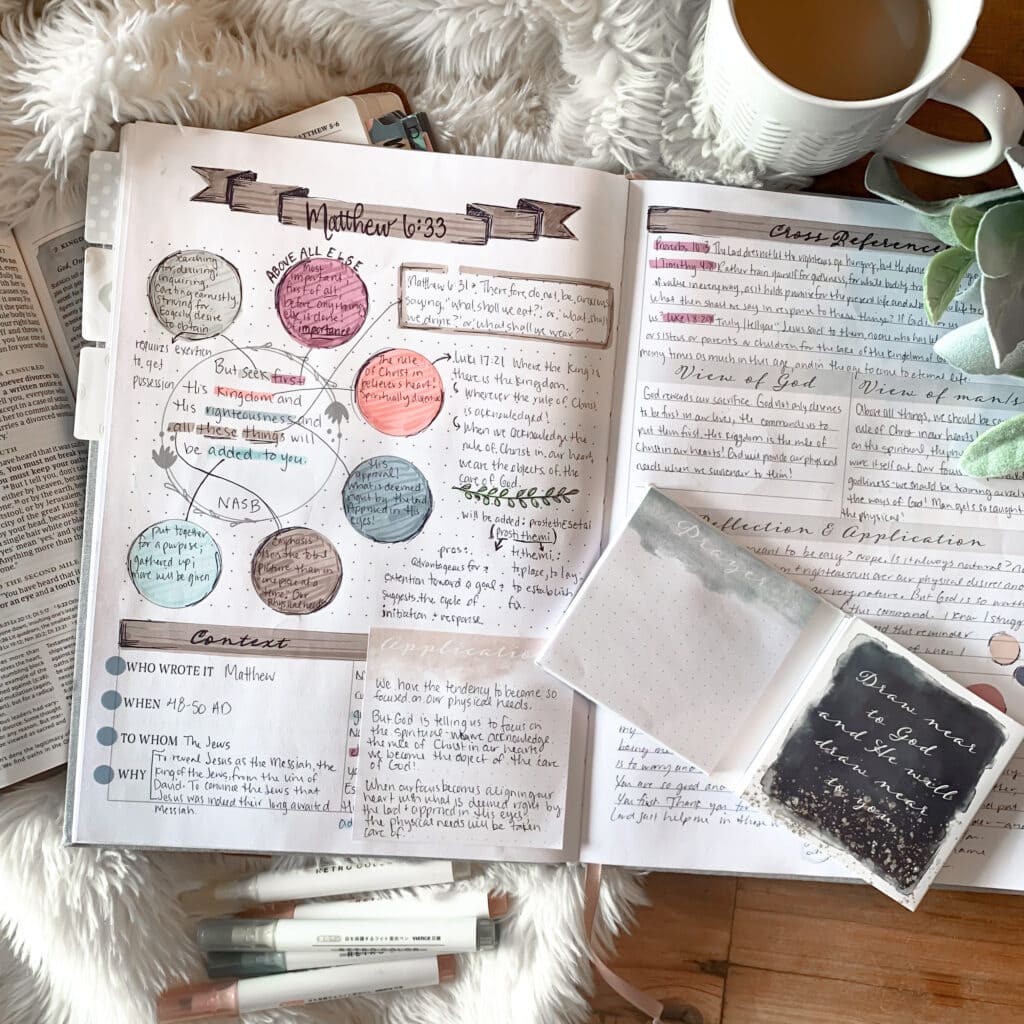Have you heard of bible verse mapping and wondered exactly what it was?
In simple terms, verse mapping is a process of understanding what a verse or passage of the Bible means so that you can apply it to your life in practical ways.
This method is a powerful tool for helping you to have a deeper understanding of God and His Word.
And the best part is that you don’t need to be a seminary-trained theologian to do it! This style of Bible study is perfect for those just getting started.

This post may contain affiliate links. Read our full disclosure here.
What is Verse Mapping?
Verse mapping is a practical Bible study method used to study and analyze individual verses or passages from God’s Word.
It involves breaking down a verse or passage into its various components, such as keywords, themes, cultural context, historical context, original languages (Hebrew and Greek), literary devices, and cross-references.
The goal of verse mapping is to gain a deeper understanding of the meaning of the scripture so you can understand it’s importance and value in practical application.
Verse mapping is often used as a tool for personal Bible study, allowing individuals to engage with the text on a more detailed and comprehensive level.
It can help uncover hidden nuances, connections to other parts of the text, and insights into the culture and beliefs of the time when the text was written.
Now that you understand what verse mapping is, let’s take a closer look at how verse mapping works.

How to Get Started with Verse Mapping
Verse mapping is simply a practical way of dissecting the Bible so you can better understand it. There are many methods for approaching the dissection process.
There isn’t a wrong way to do this method and you may create your own routine for it. But here is a basic blueprint for how to go about getting started. Consider this the beginner’s guide to Verse mapping or verse mapping in 6 steps.
- Write the verse
- Ask good questions
- Define the words
- Check cross-references
- Interpret the verse
- Apply the Verse
I’ve shared mapped out 1 Corinthians 13 on my site and hope it helps you better understand what the finished product could look like:

Step 1. Write Out The Verse
Scripture writing is a big part of the processing of understanding and retaining the verses you study. I always begin by highlighting the verse or verses in my favorite Bible and then writing then it out in my journal.
We retain what we write so I strongly advise you not to skip this step.
Step 2. Ask Questions About The Verse
Remember that the Word of God is alive and active (Hebrews 4:12) as you study the verse. It is very tempting to skim over passages we have read before or heard preached many times.
Asking questions as you study will help keep the passage fresh and alive.
Through the process of verse mapping, you will ask questions about the context and setting like:
- Who is speaking?
- Who is the audience?
- When was this written?
- Who is the verse about?
- What is the subject?
- Where was this written, or where did the audience live?
- What did this word mean to the original audience 2000+ years ago?
- How did they interpret the message?
Step 3. Define Keywords in The Verse
The Bible was written in a different language. It includes original Hebrew as well as Greek translations.
It is important to remember that we use different words today which would have had a different meaning 2000+ years ago. To better understand the verse you will need to define a specific word in the verse.
In my re-written verse in my journal, I will underline words that I don’t understand or that feel important in the passage to look up.
Some people write the verse double spaced and jot the definitions under the word in a different color pen.
That is always confusing to me, so I make a list of words under the verse in my journal, one at a time, and write the definitions there.
Because the Bible was written in Greek and Hebrew you may not get a good understanding of the verse by searching Webster’s dictionary.
Instead, you can use a free online tool called BlueLetterBible.org to find the definition of the original language. You may also find the resources from Bible Gateway helpful.
I will also often jot down synonyms of the word I am defining from Google.
Step 4. Check Cross References
Does the Bible talk about this topic or use these words in other places? Many times it does.
After you have defined the word and given yourself some notes to help make it clear, right in the BlueLetterBible you will see a section listing cross-references for the same word in other verses in the Bible.
Read the cross-references to understand the word from a different angle and often you will gain a deeper understanding of how the original audience understood the word.
Step 5. Interpret The Verse
Once you have a feel for the context of the verse, have defined the keywords, and read the cross-references you are ready to interpret the verse.
Often I will re-write the verse at this point adding clarity in parentheses (like this).
Under the verse, note some specific ways this verse applied to the original readers. Consider these main points:
- Things you want to remember
- Promises you can claim
- Truths that impact how you are living
- Further questions
Summarize the meaning of the verse or passage in my your words.
Step 6. Apply The Verse
Finally, how can you apply what the passage says to your life? Some questions I like to ask as I wind down my time with God are:
- What needs to change in my life based on what God has said?
- Is God convicting me of any sin or idolatry?
- Are there things wrong in my theology?
- Are there promises that can help me in this season?
- Can I turn the passage into a prayer?
This is my favorite time of Bible study. It often leads to a worship song and a time of prayer. When you slow down your time in the Word, you hear God speak into your right now situation. I love that!
Here is an excellent example of Verse Mapping Joshua 1:9.
Supplies Needed for Verse Mapping
It is not expensive to start verse mapping. Most of the supplies I use are things I have around the house, to begin with, so it could be free if you play it right.
I will often pull things out of old scrapbooking tubs. Bible Journaling supplies also come in handy. Honestly, sometimes this transitions to Bible Journaling for me.
A keyword will spark an image and I will start doodling in my journal or in my Bible as I meditate on it.
1. A Bible
When studying the Bible through Verse mapping you really want a Bible translation that is easy for you to read. If you have a King James Version and struggle to get into the habit, it could be that Old English is just too foreign to you to relate to.
You may find that a new translation such as NIV or CSB enables you to better understand each verse.
You should also compare 2-4 different translations of a verse because each one may use different modern words or phrases to capture the essense of the meaning.
You may also want to use a life application study Bible or NIV verse mapping Bible because they can provide additional study material for better understanding.
If you aren’t quite sure which Bible to get started with, here are some great Study Bibles for Beginners.
2. A Note Book
When you are dissecting a verse or passage of scripture in the Bible expect it to take space. You need a designated notebook – or verse mapping journal – to keep track of your study.
You can use just a regular lined (or no line) notebook. You can also find printable verse mapping sheets to insert into a diy notebook.
I enjoy this pretty watercolor blank notebook.
After you map a few verses you will know what works for you. Give yourself grace that this doesn’t have to look perfect, it just has to help you dive deeper into the Word.
3 . Pens or Pencils
I am a colorful pen girl, but it doesn’t really matter what kind of writing instrument you use. You could use one pen or one pencil. You may prefer to use different colors.
My favorite is this multicolored set from Pembrook. They are cheapest on Amazon but can be picked up from Walmart.
4. Study Tools
Earlier I mentioned BlueLetterBible.org as a great free online tool for getting definitions and cross-references. I love this tool but it does have some limits. You may prefer to have a good Bible dictionary on hand to help you go deeper.
There are also many times I need to go deeper than definitions and cross-references to understand a passage.
Commentaries are great tools to go deeper.
Free Printable Bible Verse Mapping Template
What better way to get started with verse mapping that with a verse mapping template! You can download this free printable template to use as you get started.

Feel free to download and make as many copies as you need.
Here is a more indepth Verse Mapping template that my friend Teresa created that you might want to check out:

Verse mapping is a great way to refresh your quiet time. Whether you struggle to understand the Bible or you are just going through a dry season, this method can bring value to your Bible study time.
But keep in mind, there no one right way, nor is there really a wrong way, of studying the Bible. There are actually a bunch of different ways to go about it and everyone learns differently so you need to find a method that suits your learning style.
Verse mapping is just one creative way to study the Bible.
I pray this new way of diving deeper into scripture will help on your spiritual growth journey and growing closer to God.

Another great resource to checkout is The James Method.
They have some really great verse mapping templates and other tools for you to really dive deep using this Bible study method.
